
Eudonia philerga is a species of moth of the family Crambidae. This species was first described by Edward Meyrick. It is endemic to New Zealand, found throughout the country, and regarded as common. Larvae feed on moss. Adult moths have been observed on the wing more frequently from October to April, and are attracted to light.

Asaphodes is a genus of moths in the family Geometridae erected by Edward Meyrick in 1885. This genus is endemic to New Zealand and species within this genus are found throughout New Zealand including the North, South and Stewart / Rakiura Islands.

Hendecasticha is a genus of moths belonging to the subfamily Olethreutinae of the family Tortricidae. This genus was described by Edward Meyrick in 1881. It consists of only one species, Hendecasticha aethaliana, which is endemic to New Zealand.

Parienia is a genus of moths belonging to the subfamily Olethreutinae of the family Tortricidae. This genus was described by Edward Meyrick in 1881. It consists of only one species, Parienia mochlophorana, which is endemic to New Zealand.

Elachista ochroleuca is a moth in the family Elachistidae. It was described by Edward Meyrick in 1923. It is endemic to New Zealand and has been observed in the South Island. The adults of this species are day flying and are on the wing from October until March.
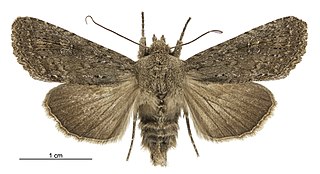
Physetica homoscia is a species of moth of the family Noctuidae. It is endemic to New Zealand and is found throughout New Zealand including in the Auckland Islands. This species inhabits places where its host plants are common and this includes costal dune habitat. It lives at a wide range of altitudes from sea-level up to at least 1750 m. The larvae of P. homoscia feed on Ozothamnus leptophyllus and Ozothamnus vauvilliersii. They are very active and drop to the ground when disturbed. Larvae are parasitised by a species of fly. This species pupates in the soil and the pupa life stage lasts for approximately 6 weeks. The adult moths are on the wing from September to June and are attracted to light. The adults of P. homoscia might possibly be confused with Ichneutica moderata however this latter species lacks the small white dots on the forewing veins of P. homoscia. Adults might also be confused with P. temperata but P. homoscia is significantly larger in size.

Tingena aletis is a species of moth in the family Oecophoridae. It is endemic to New Zealand and has been collected in the vicinity of Arthur's Pass in the South Island. Adults are on the wing in January.

Tingena melanamma is a species of moth in the family Oecophoridae. It is endemic to New Zealand and has been observed in Marlborough, Otago and Southland.

Tingena pharmactis is a species of moth in the family Oecophoridae. It is endemic to New Zealand and has been observed in the Nelson, Tasman and Wellington regions. The adults of this species are on the wing in December.
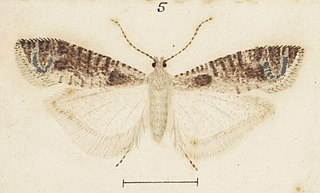
Holocola dolopaea is a species of moth in the family Tortricidae. It was first described in 1905 by Edward Meyrick. The species is endemic to New Zealand and has been observed in Whangārei, Hawkes Bay, Wellington and Christchurch. This species inhabits native forest or scrub glades. Adults are on the wing from September to December and are attracted to black light. This species is regarded as being rare.
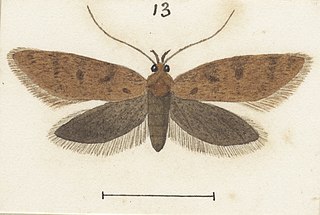
Euchersadaula lathriopa is a moth of the family Oecophoridae. It was first described by Edward Meyrick in 1905. This species is endemic to New Zealand.
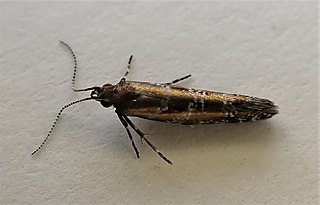
Chrysorthenches drosochalca is a species of moth in the family Plutellidae first described by Edward Meyrick in 1905. It is endemic to New Zealand and has been found in the North and South Islands. The larvae are leaf miners of Prumnopitys ferruginea. Adults are on the wing from January to March.
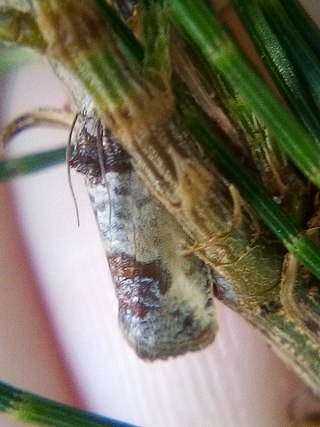
Argyroploce chlorosaris is a species of moth in the family Tortricidae first described by Edward Meyrick in 1914. This species is endemic to New Zealand. The classification of this moth within the genus Argyroploce is regarded as unsatisfactory and in need of revision. As such this species is currently also known as Argyroploce (s.l.) chlorosaris.

Holocola charopa is a species of moth in the family Tortricidae. It was first described by Edward Meyrick in 1888. It is endemic to New Zealand and has been observed in the northern parts of the North Island. The larvae web together and feed on the new shoots of their host plant Kunzea ericoides. Adults are on the wing in July and from November until February.
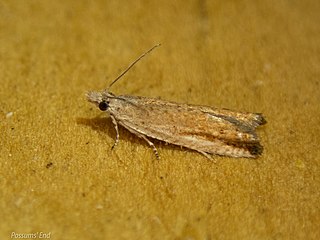
Holocola zopherana is a species of moth in the family Tortricidae first described by Edward Meyrick in 1881. This species is found in Australia and New Zealand. The larval hosts of this moth are Kunzea ericoides as well as species within the plant genus Leptospermum.

Holocola emplasta is a species of moth in the family Tortricidae. This species is endemic to New Zealand and has been observed in the South Island. The larval hosts are species within the genus Coprosma. Adults of the species are on the wing during the New Zealand spring months.

Holocola parthenia is a species of moth in the family Tortricidae. It is endemic to New Zealand and has been observed in the North, South and the Chatham Islands. Larvae feed on Leucopogon fasciculatus. This moth is one of the earliest to emerge in the New Zealand spring with adults being observed from August to December. Adults are attracted to light.

Prothelymna potamias is a species of moth in the family Tineidae first described by Edward Meyrick in 1909. This species is endemic to New Zealand.
Strepsicrates melanotreta is a species of moth in the family Tortricidae first described by Edward Meyrick in 1905. This species is endemic to New Zealand.

Chrysorthenches is a genus of moths of the family Plutellidae.



















